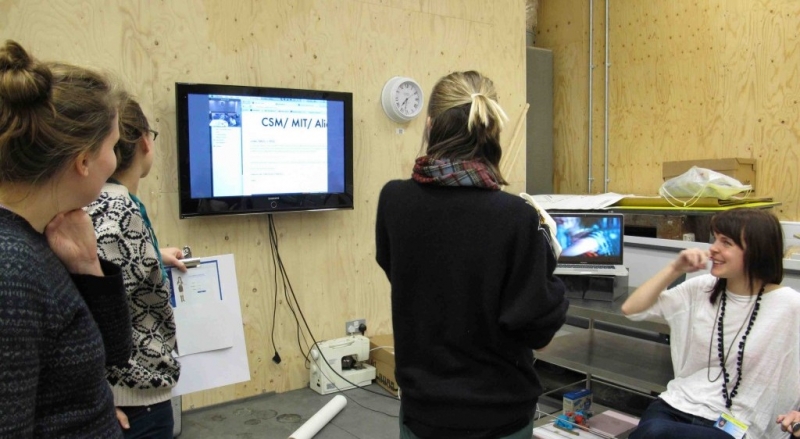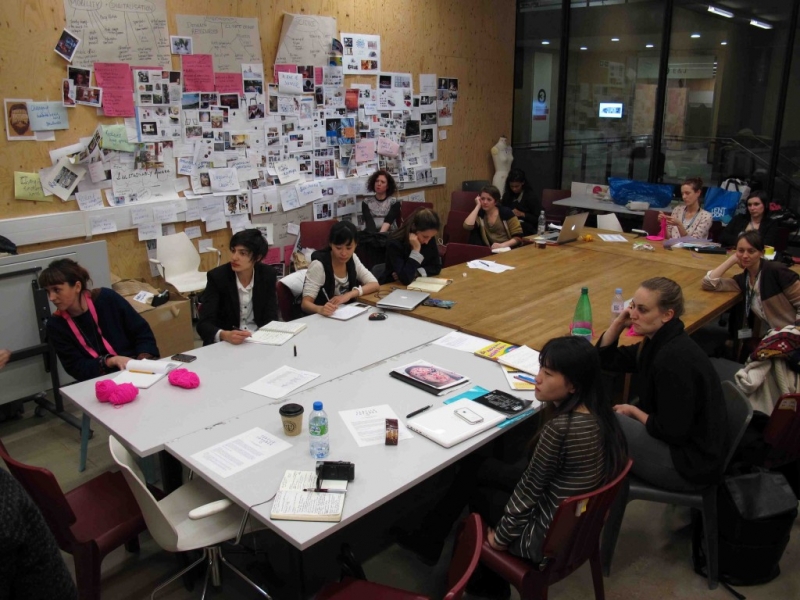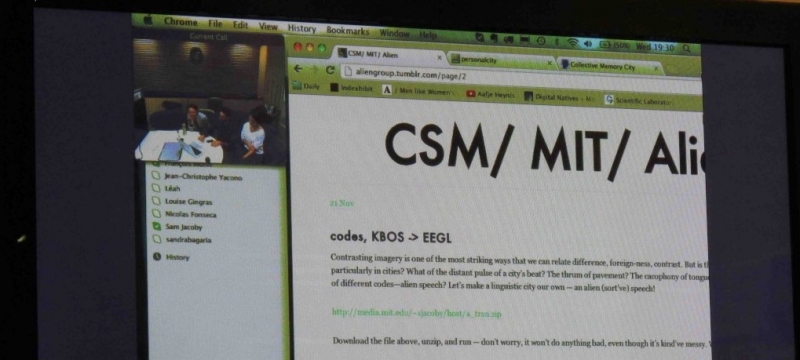Skype at CSM: staff survey feedback
Historically Central Saint Martins has had a tricky relationship with Skype. For a number of years, and for a number of reasons, Skype services were not accessible through the university’s network. Whilst one argument maintained that the university’s ‘digital experience’ provision was less than staff and students would expect when outside of the institution, a counter claim was that Skype used excessive bandwidth and posed potential security issues for the university network as a whole. Both points were valid, and the situation highlights the complex issues faced by institutions worldwide when dealing with the rapid advancement of digital systems.

CSM MIT collaborative workshop using Skype
Today, however, as highlighted in the recent CSM Social Media and Digital Tools survey, there is a marked increase in the number of staff using Skype as part of their university life.
Before discussing the ways in which colleagues are employing Skype, and providing a summary of the current university position regarding the services – what is Skype? Bought by Microsoft in 2011, Skype is a platform that has been around for a decade. It enables people to communicate over the internet by voice (microphone), video (webcam), and instant messaging. The service is free if you communicate with another Skype user, but you will need to pay if talking with someone on a mobile or landline telephone.
The staff survey shone a light on the surface of staff relationships with digital technologies and revealed that 32% of colleagues are using Skype in various ways as part of their College roles (63% use Skype outside work). The main activities being:
Interviews prospective students, prospective staff, international auditions
Meetings with colleagues who are away from college, multi-partner research collaborations, multi-partner commercial collaborations, virtually joining physical meetings held in the college
Teaching tutoring students who are overseas, feeding back to students at CSM when the staff member is abroad, undertaking PhD tutorials
Collaborative workshops international student collaborative workshops to support learning
Communication touching base with students who are abroad, maintaining contact with research contacts, reducing the amount of physical visits needed to support a joint project.

CSM students viewing MIT presentation
CSM MA Textile Futures and MIT student collaborative workshop using Skype
In the Autumn Term 2012-13 a vibrant collaborative project exploring the super-natural city through multiple interpretations, culminated in a lively two-hour video workshop between CSM students in London, and MIT students in Massachusetts. Over twenty people took part in the workshop, presenting and discussing project outcomes and processes with one another.
This extraordinary event included technical seams, where the technology’s rupture, disjunction and distortion led to delightfully creative miscommunication and verbal mutations; the discontinuity of time and space leading to moments of unanticipated playfulness and humour. I found the exchange of ideas to be inspiring and fulsome – with the use of Skype as a video conferencing service successfully enabling this engaging and valuable session.

Skype session screen
As we often experience, the linking of physical and digital spaces can be full of seams, glitches, and various technical problems. Thus when conceiving of e-Learning activities it is useful to think about the things that may go wrong, and how you can work around the potential situation. Technologies aren’t always stable for many reasons. Equally the relationship between the physical space and the digital space needs to be appropriate. There is no point producing a video Skype session when there isn’t a sufficient signal in the room being used, or trying to use voice recognition software in an open plan office. When conceiving of ‘e-Learning’, the physical landscape is as important as the digital landscape.
Skype and the university
Philip Gourlay, Associate Director of IT at UAL, noted that ‘currently there is no policy regarding the use of Skype, and at present although IT has no objection to staff using the software we have no expertise in house to support it.’
‘As we develop an approach to Software Asset Management we will include a
review of what applications are recommended and what are supported, until
then Skype can be installed on a University computer without warranty or
support and operated by a user in line with our Acceptable Usage Policy.’
Skype at CSM: staff survey feedback from the fantastic CSM Digital Present blog here.
Links
Facebook and Blogs at CSM http://digitalpresent.myblog.arts.ac.uk/2012/12/04/facebook-and-blogs-staff-survey-feedback-2012/
JISC: Using digital media for teaching and leaning http://www.jiscdigitalmedia.ac.uk/guide/using-digital-media-for-teaching-and-learning
Perceptions and reflections: Using Skype chat to develop a community of learning http://www.academia.edu/974813/Perceptions_and_reflections_Using_Skype_chat_to_build_a_community_of_learners
CSM MA Textile Futures http://www.csm.arts.ac.uk/courses/ma-textile-futures/
UAL IT Acceptable Usage Policy http://www.uarts.edu/about/acceptable-use-policy

This text, Skype at CSM: staff survey feedback, by Jo Morrison is licensed under a Creative Commons Attribution-NonCommercial-ShareAlike 3.0 Unported license. There are alternative licensing options available.


